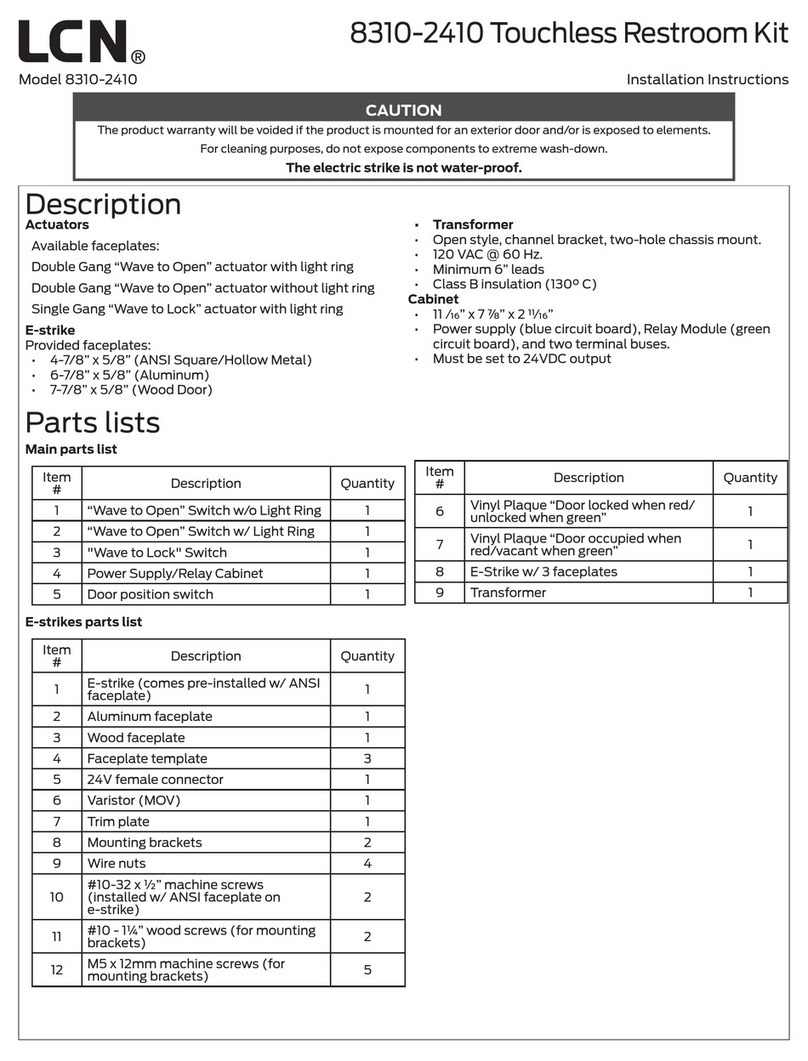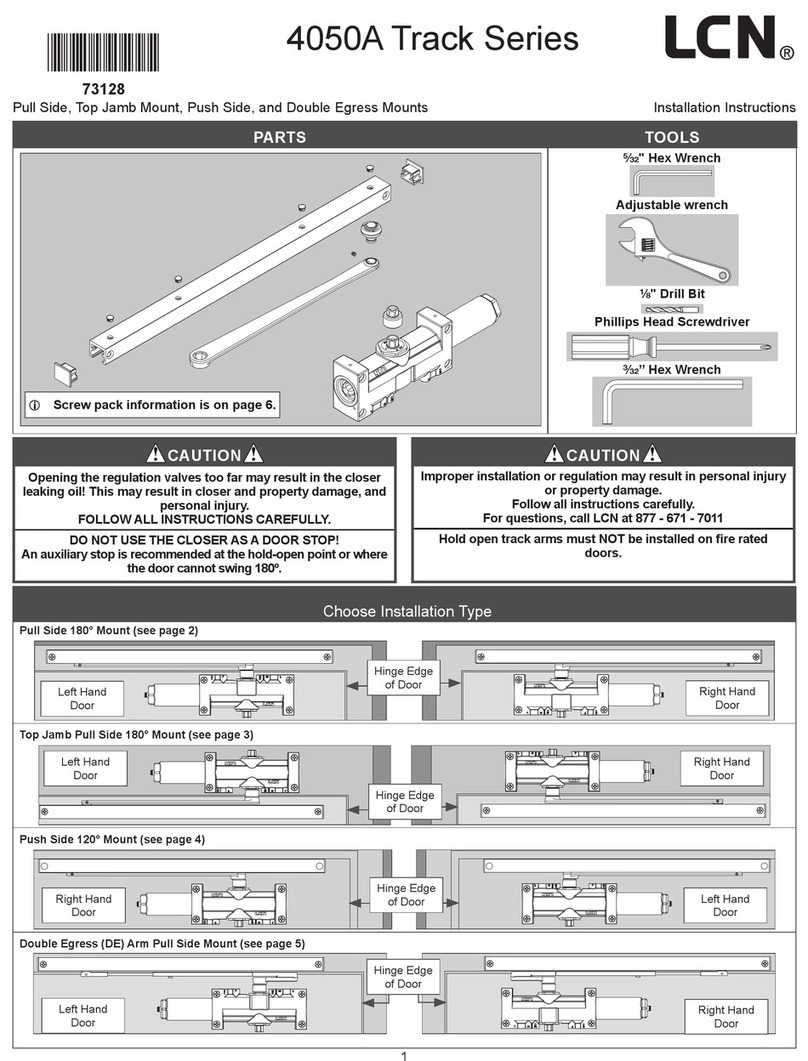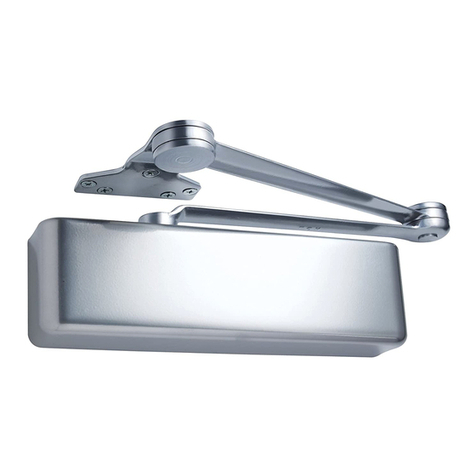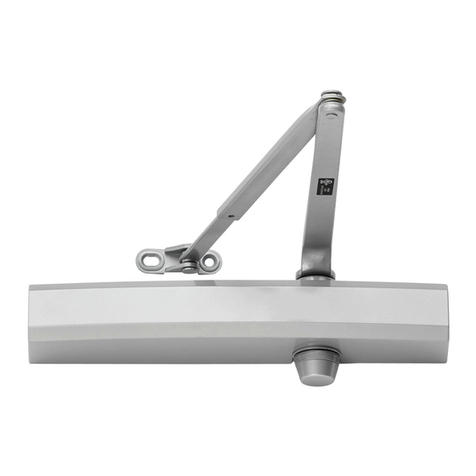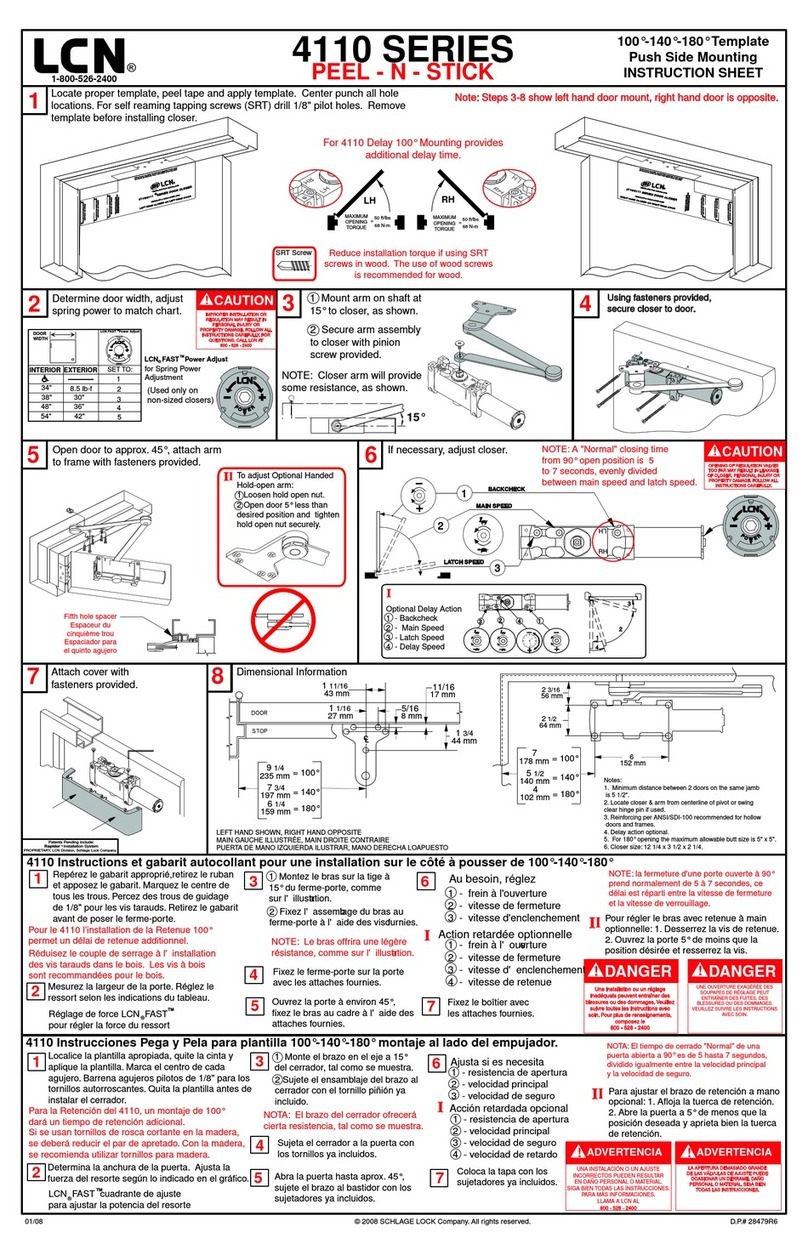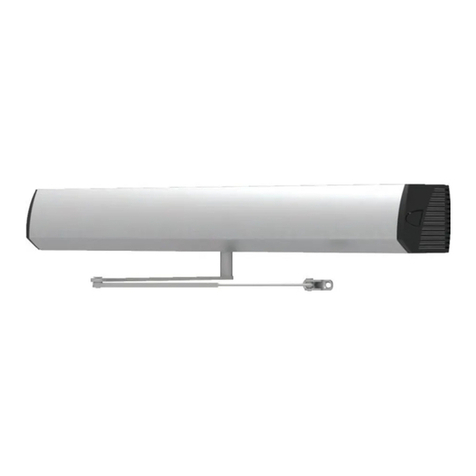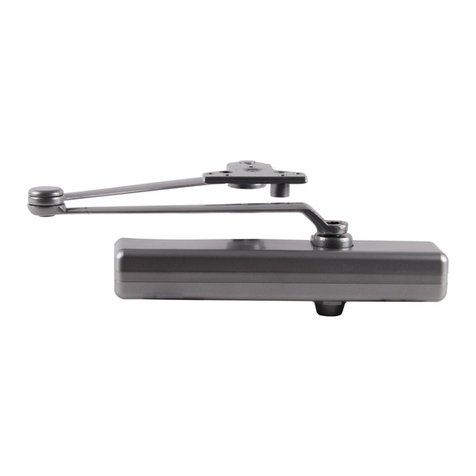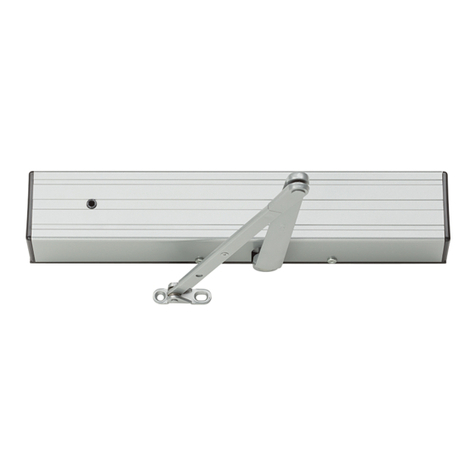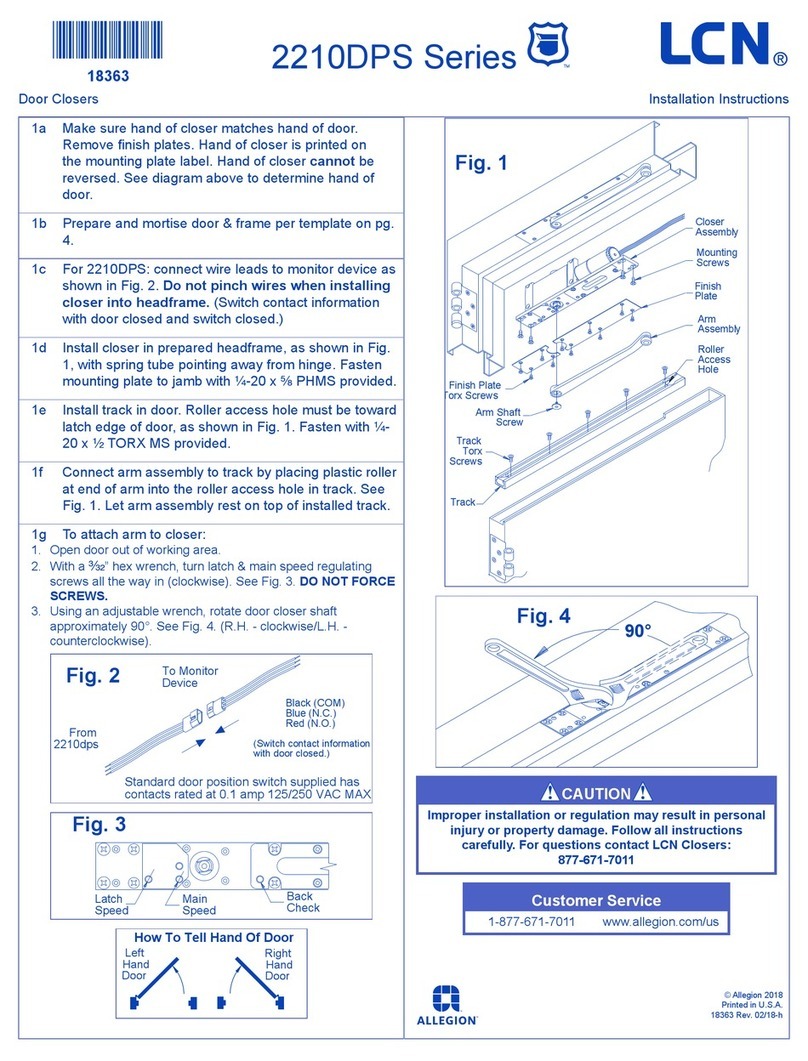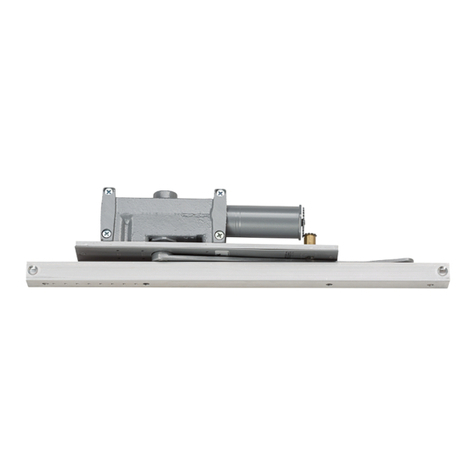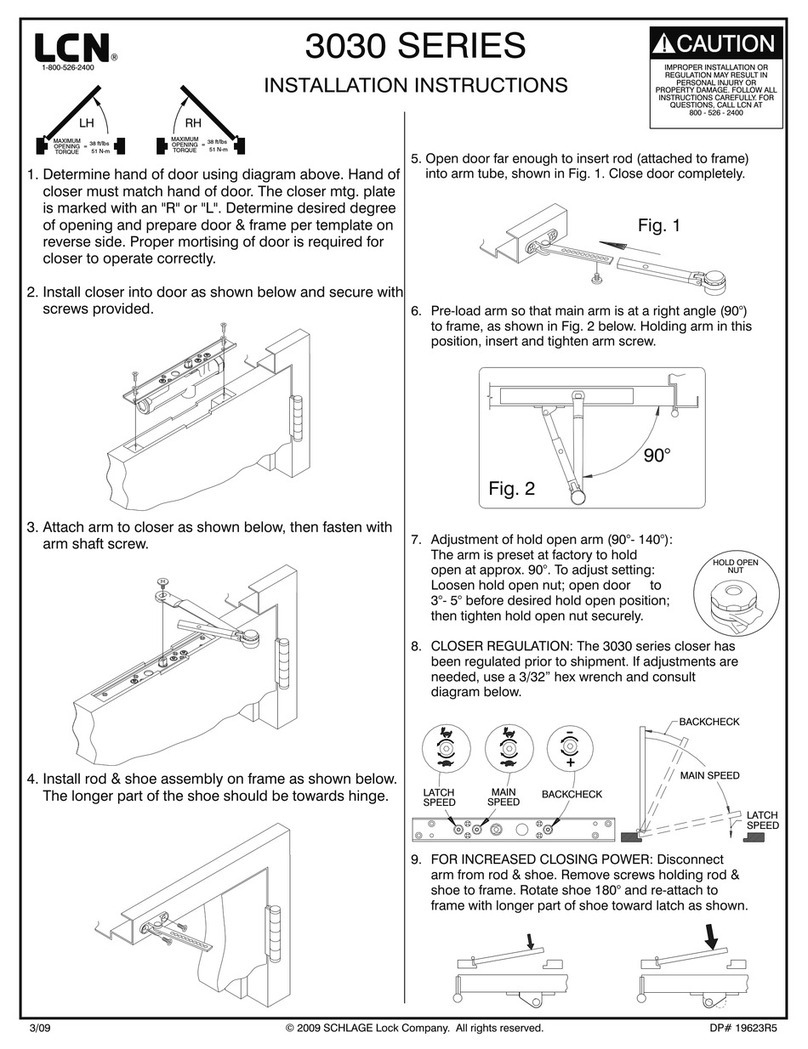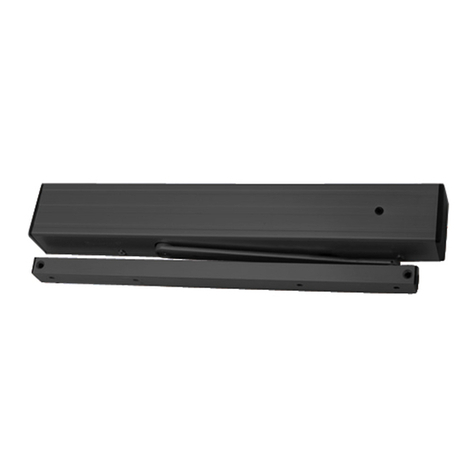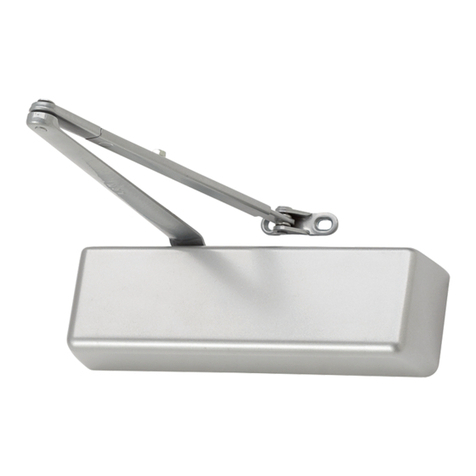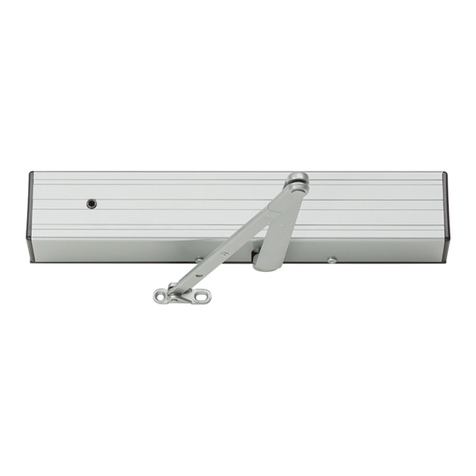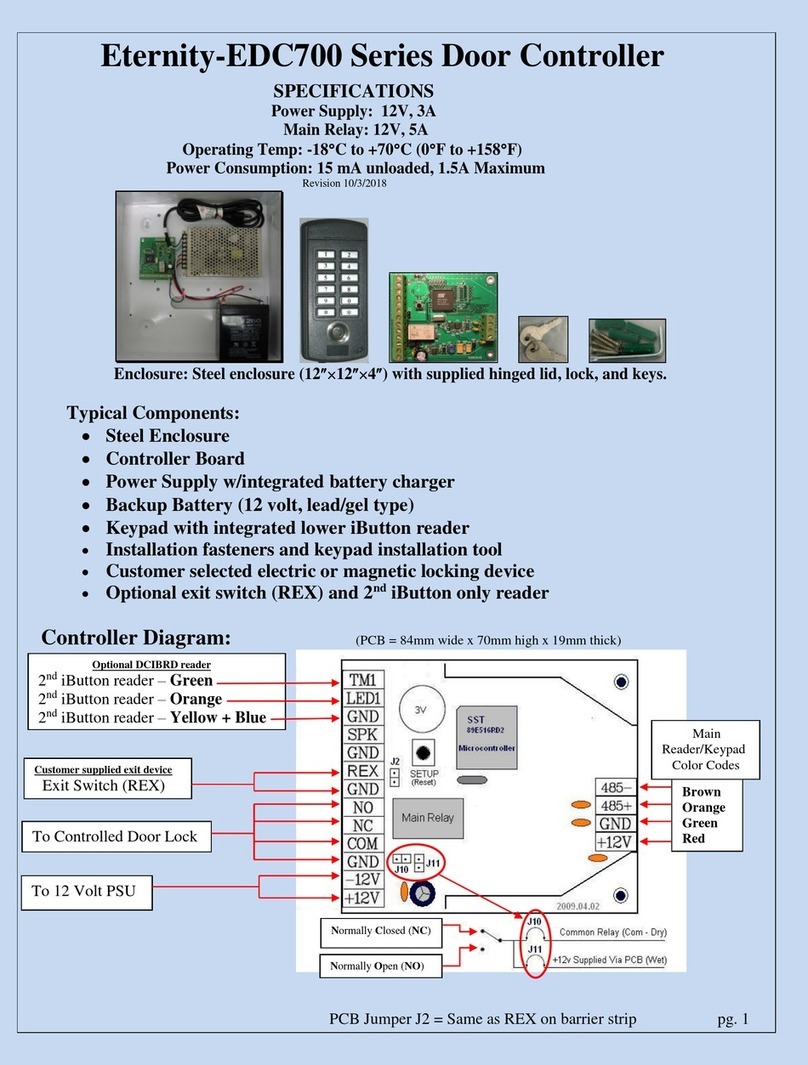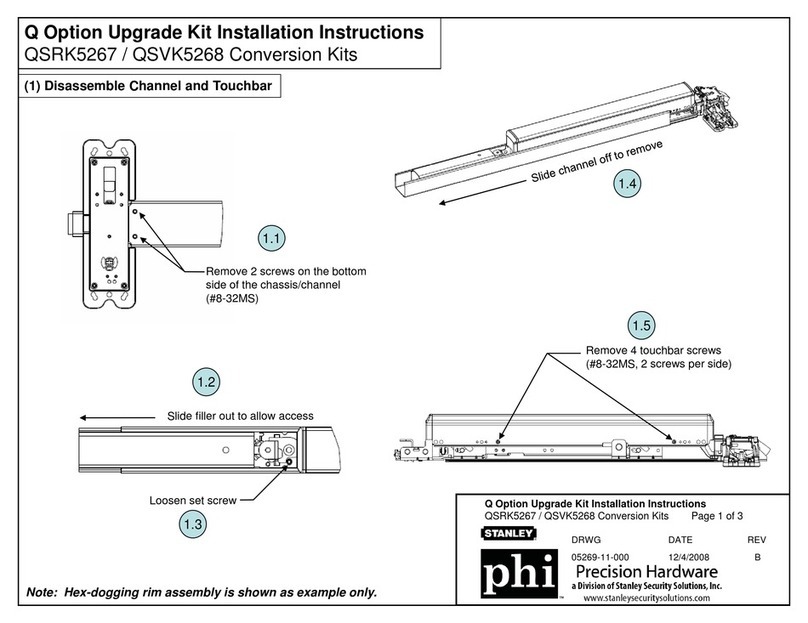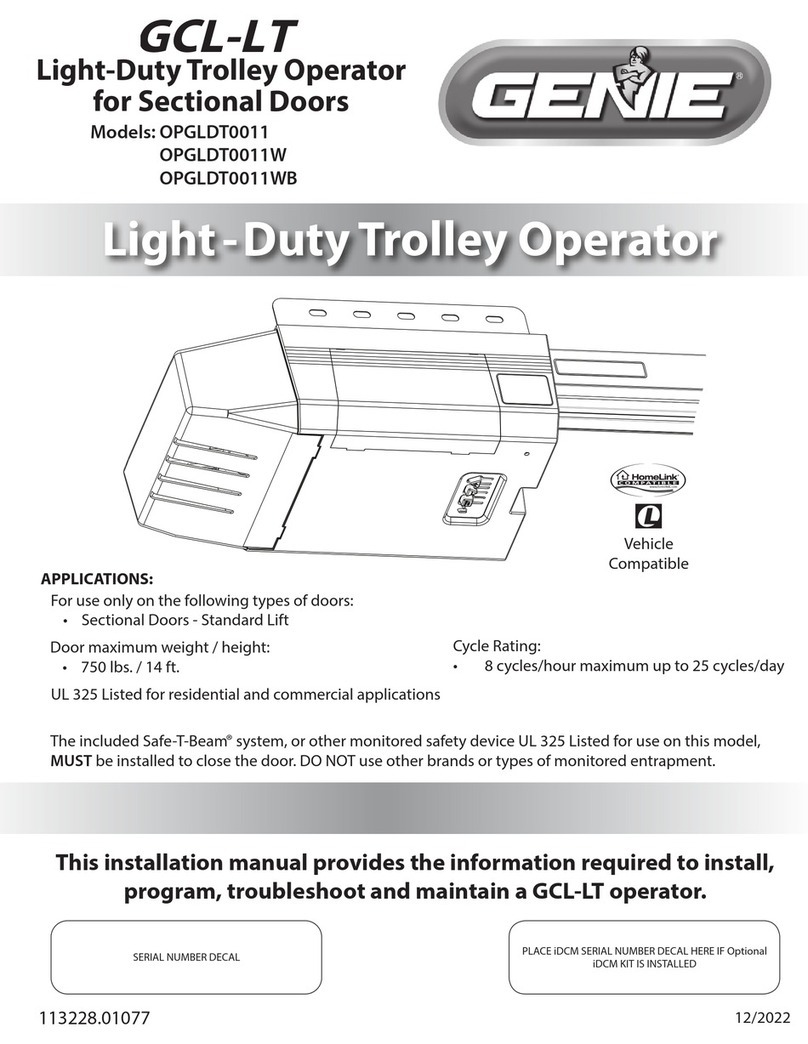LCN Benchmark III 9130 User manual

Installation Instructions 740158-00
Benchmark®III
Swing Operator
Models: 9130, 9140, & 9150
121 West Railroad Avenue
Princeton, IL 61356-0100
800-526-2400
FAX: 800-248-1460
www.lcn.ingersollrand.com
740158-00
(
1
)
©
2008 In
g
ersoll-Rand Com
p
an
y
Limited

Page 2 of 19
General 2
Replacement Parts and System Components 2
1. Pre-Installation Site and Product Check 4
2. Operator Installation 5
3. Wiring 9
4. Arm and Cover Installation 10
5. Operational Check 12
6. Operator Adjustment 15
7. Release for Service 17
8. BenchMark III Software 18
GENERAL
The Benchmark is an automatic electromechanical swinging door operator for use on hinged,
center pivoted and offset pivoted doors. When activated, the Benchmark drives the door to full
open position, then electrical power is turned off and the door is closed by spring force. The
activating circuit opens the door from any position in the closing swing. During a power failure,
the Benchmark acts as a manual door closer (Size 3). Door opening and closing cycles,
including opening speed, back check speed, hold open time delay, closing speed, and latch
position, are adjustable.
Part 27” Header Full Length Header
Single Full Length Header
Double
Premium Control
Box 9130-3462SC
9140-3462SC 9130-3462SC
9140-3462SC 9150-3462SC
Gear Box 9130-3454S
9140-3554S 9130-3454
9140-3454 9150-3454S
End Caps 9130-334 9140-334 9150-334
Part Pull Standard Push Extended
Reveal Push Finish
Arm Assembly 9130-3077T 9140-3077
9150-3077 9140-3077L
9150-3077L US28
DC13
CONTENTS
REPLACEMENT PARTS & SYSTEM COMPONENTS

Page 3 of 19
REPLACEMENT PARTS & SYSTEM COMPONENTS (CNTD)

Page 4 of 19
1.1 Check that the Product Model is correct for the required application.
1.2 Check that all parts listed on the Bill of Material are in the shipping container.
1.3 Check the architectural drawings and final approved shop drawings for the position
of frame and structural openings.
1.4 Check header and frame dimensions and required clearances.
1.5 Check Door Width: 26” minimum for 27” Push Operator
30” minimum for 27” Pull Operator
36” minimum for Full Length Push or Full Length Pull Operators
1.6 Check that Door Weight is 200 lbs. or less. For heavier door, consult factory.
1.7 Check that a 115 volt, single phase, 60 Hz, fused 15 amp, 3-wire power supply is available
at the side jamb with approximately 12” of wire available to connect to the Operator.
UL approved flexible conduit is recommended for the 115 volt power line.
The 115 volt power supply must be a dedicated circuit from the main circuit breaker panel
and must NOT be connected into any building lighting system that operates flourescent
lights.
1. PRE-INSTALLATION SITE & PRODUCT CHECK

Page 5 of 19
2.1 Remove Control Box from Operator Mounting Bracket, then remove Motor/Gearbox from
Bracket:
2.2 Prepare Header/Frame and Door: 27” Pull System..............................Page 6
Full Length Pull System..................Page 6
27” Push System............................Page 7
Full Length Push System ...............Page 7
Double Push System......................Page 8
Low Ceiling Application..................Page 8
2.3 Install Operator Mounting Bracket on Header/Frame.
For Full Length systems, also install Switch Bracket on Header/Frame.
2.4 Install Motor/Gearbox on Operator Mounting Bracket.
Then install Control Box on Bracket.
2.5 Proceed to Chapter 3: Wiring (Page 9).
2. OPERATOR INSTALLATION

Page 6 of 19
27” Pull System
Header/Frame and Door Preparation
Full Length Pull System
Header/Frame and Door Preparation
Center Operator Cover (with End Caps removed) over opening and mark a vertical line at each
end. Align ends of Operator Mounting Bracket and Switch Bracket with vertical lines and adjust
vertical position per diagram below. Mark and prepare mounting holes.
2. OPERATOR INSTALLATION (CNTD)

Page 7 of 19
27” Push System
Header/Frame and Door Preparation
Full Length Push System
Header/Frame and Door Preparation
Center Operator Cover (with End Caps removed) over opening and mark a vertical line at each
end. Align ends of Operator Mounting Bracket and Switch Bracket with vertical lines and adjust
vertical position per diagram below. Mark and prepare mounting holes.
2. OPERATOR INSTALLATION (CNTD)

Page 8 of 19
Double Push System
Header/Frame and Door Preparation
Center Operator Cover (with End Caps removed) over opening and mark a vertical line at each
end. Align ends of Operator Mounting Bracket and Switch Bracket with vertical lines and adjust
vertical position per diagram below. Mark and prepare mounting holes.
Low Ceiling Application (27” Push System Only)
Header/Frame and Door Preparation
2. OPERATOR INSTALLATION (CNTD)

Page 9 of 19
TION
3.1 Refer to the appropriate wiring diagram for the Control Box (Page 19) or the diagram
supplied for custom applications.
Connect the following cables:
•Ground Cable (Ground the Operator properly with the earth from main supply)
•Hall Effect Cable (Do not wrap the Hall Effect Cable around the Motor Power Cable)
•Motor Power Cable (Do not wrap the Motor Power Cable around the Hall Effect Cable)
•Control Box Power Cable
3.2 Connect Activate, Safety, Key Switch, and lock accessories, as needed.
Refer to the accessory instructions for any accessories used.
Do not connect any remote activating device to the door unless it is located within
line of sight of the door.
3.3 When wiring is complete, proceed to Chapter 4: Arm and Cover Installation (Page 10)
3. WIRING
CAUTION
• Make sure all wires are properly dressed and secured to prevent interference
• Route all wiring away from moving parts, sharp edges, and heat sources
• Use copper conductors only
• Do not modify the factory wiring or connect into existing electrical circuits or devices

Page 10 of 19
WARNING
Keep hands, clothing, wires, tools, etc., AWAY FROM Operator Motor
when the Operator Motor is turned on
4.1 Make sure the Operator Powers is turned Off.
4.2 Install a jumper across the control box Main Act and Main Act.
4.3 Turn the operator power switch to On.
The operator motor will activate and drive to the Full Open position.
4.4 Attach the arm to the operator spindle loosely with the 8mm socket head screw.
For push systems, ensure that the adjusting boss is inserted correctly.
4.5 Attach the arm to the door.
4.5.1 For push systems, attach the push arm shoe to the door:
4. ARM & COVER INSTALLATION

Page 11 of 19
4.5.2 For pull systems, slide the pull arm roller into the track, then insert a track cap
on each end of the track and attach the track to the door:
Pull Arm
4.6 Adjust arm:
4.6.1 For pull systems, remove the locking screw from the arm.
4.6.2 For push system, remove the locking screw from the arm.
Pull Arm Push Arm
4.6.3 Keep the door in the full open position and adjust the arm length as necessary
to align the door at 90 degrees from closed.
When the arm is adjusted to the correct length, tighten the 8mm socket head screw
that secures the arm to the operator spindle.
Ensure this screw is secure, then tighten the arm locking screw.
4.7 Turn Off the power operator switch. The door should close.
4.8 Remove the jumper from the control box Main Act and Main Act.
4. ARM & COVER INSTALLATION (CNTD)

Page 12 of 19
4.9 Test the operator. (See Chapter 5: Operational Check on Page 13)
4.10 Adjust the operator as required. (See Chapter 6: Operator Adjustment on Page 15)
4.11 Snap the optional end cap insert (in bag of screws) into end cap opposite
the On/Off switch.
4.12 Install the cover assembly onto the operator.
4.13 Release the operator for service. (See Chapter7: Release for Service on Page 17)
4. ARM & COVER INSTALLATION (CNTD)

Page 13 of 19
5.1 Set the key switch to Auto (if used) and turn on the operator power switch.
5.2 Activate the operator using the activation device.
The operator will perform one sizing cycle.
Sizing Cycle: Occurs after power is turned on and a legitimate activation signal
is received. During the sizing cycle, the door opens and closes one time.
5.3 If the Door does NOT OPEN AT ALL during the sizing cycle:
• Check the door for binding.
• If an electromechanical lock is being used, check that the lock disengages before the
operator opens the door.
• Check fuses, circuit breakers and connections.
• Adjust the operator and check the door operation
(See chapter 6: Operator Adjustment on Page 15)
Opening Speed 75%
Back Check Speed 75%
Hold Open Time Delay Minimum
Latch Position Maximum
Closing Speed 50%
SW1 1,2,3,4 OFF
5.4 If the door does NOT OPEN FULLY during the sizing cycle:
• Check the door for binding.
• Increase the back check speed slightly and re-check the door operation.
Repeat until door opens fully.
5.5 If the door SLAMS OPEN during the sizing cycle, decrease the back check speed
slightly and re-check the door operation. Repeat until the door opens without slamming.
5.6 After the sizing cycle is completed and the door(s) are closed, apply a maintained
activation signal. Check that the door remains open while the signal is applied.
5.7 If a door safety device is being used:
5.7.1 Door Open Safety:
When the door is in the closed position, activate the safety device and try to activate
the door open. The door should remain closed.
5. OPERATIONAL CHECK

Page 14 of 19
5.7.2 Door Close Safety:
When the door is in fully open position, activate the safety device and the door should
remain open.
5.8 When the door is operating properly, continue with Step 4.10 on Page 12.
5. OPERATIONAL CHECK (CNTD)

Page 15 of 19
See table below and diagrams (Page 16) for operator feature adjustment.
After adjusting, cycle the door several times to check for proper operation.
Then continue with Step 4.11 on Page 12.
NOTE
Adjust Operator for the SLOWEST operation practical, in accordance with the latest
revisions of the Americans with Disabilities Act (ADA); ANSI/BHMA A156.19 Standards
for Power-Assisted and Low Energy Power-Operated Doors; and local codes.
Opening Speed: 5 seconds or more Latch Location: 10 degrees or more
Closing Speed: 3 seconds or more Latch Speed: 1.5 seconds or more
Features Control Description Counter
Clockwise Clockwise
Opening
Speed Opening
Speed
Controls opening speed of door Slower Faster
Back Check
Speed Back Check
Speed Controls the speed of the door
near the full open position to
prevent door slamming
Slower Faster
Hold Open
Time Delay Hold Open
Time Delay Controls the length of time the
door remains in the full open
position: 1 sec to 15 sec
Less Time
Down to
1 sec
More Time
Up to
15 sec
Back Check
Position Back Check
Position Door position where back check
speed engages Less
Pressure
Required
More
Pressure
Required
Latch
Position Latch
Position Door position at which
deceleration towards full closed
begins in order to prevent door
slamming
Less
Latch More Latch
Closing
Speed Closing
Speed
Controls closing speed of door Slower Faster
Delayed
Activation
DLY (SW1)
Delays opening of door for
strike applications (1 second
delay)
Push and
Go PNG (SW2)
ON: Pushing the door open 5°
causes operator to open door
for remainder of open cycle
Power
Boost
On or Off
PB (SW3) ON: 3-second power boost
enabled: applies additional
force to close door—used for
high wind situations
SW4 Not used
6. OPERATOR ADJUSTMENT

Page 16 of 19
-+
Less More
Backcheck
Position
Latch
Position
MoreLess
+-
-+
Less More
Open
Speed
Time Delay
MoreLess
+-
Backcheck
Speed
MoreLess
+-
-+
Less More
Close
Speed
OFFON
4
PB
PNG
DLY
6. OPERATOR ADJUSTMENT (CNTD)

Page 17 of 19
7.1 Remove all tools, installation equipment and debris from the vicinity of the door.
7.2 MANDATORY: Install all Safety, Traffic Control and Instruction Labels onto the door,
as required.
Failure to do this will leave the INSTALLER LIABLE for any accidents that occur.
7.3 Give verbal instruction on how to properly operate the door to the owner or
person in charge.
7.4 Give verbal instruction to the owner or person in charge on periodic inspection of the
door for the following:
• Occasional damage
• Developing problems
• Minor preventative maintenance
7.5 Provide the owner or person in charge with a contact name and phone number to call
for future service and maintenance.
IMPORTANT
Be sure to install all Safety, Traffic Control and Instruction Labels
onto the door, as required
7. RELEASE FOR SERVICE

Page 18 of 19
8.1 Operation:
8.1.1 Sizing
From start-up (Sizing), the door will activate via:
• 1-Way Input (Main Act and Main Act).
• 2-Way Input (3-Way ON, 3-Way HO and 3-Way GND) with key switch in the ON
position, uses either Main Act or Aux Act input
• Key switch in Hold Open position.
The first motion of the door will be towards the Door Open position. The speed during
Sizing is automatic and cannot be set from a potentiometer.
The door drives to full open and the system sets the open counter to full open.
The door closes at Closing Speed. The system sets the closed counter to Full Closed
when the latch goes up at the Closed position.
The system calculates all other parameters required for normal operation based on the
two values of Full Open and Full Closed.
8.1.2 Standard Operation
Upon a legitimate activation signal, the door accelerates to opening speed while
monitoring the current load on the drive output. If the current exceeds the specified
level, the door will stop and close.
The door travels at it’s set speed (based on the potentiometer setting) until it reaches
the Back Check position, where it will decelerate to the Back Check Speed.
The door will stop at the Hold Open position and remain there until an activation or the
Hold Open Timer is cleared.
The door then closes at its Closing Speed (based on the potentiometer setting) up to the
latched position.
If the Closing Speed is decreased by driving the motor in the open direction (a fixed
setting), power is added to allow the spring to continue closing the door to the Full
Closed position.
8. BENCHMARK III SOFTWARE

Page 19 of 19
8.3 Wiring
8. BENCHMARK III SOFTWARE (CNTD)
This manual suits for next models
2
Table of contents
Other LCN Door Opening System manuals
Popular Door Opening System manuals by other brands

hager
hager 4600 Series Installation instruction
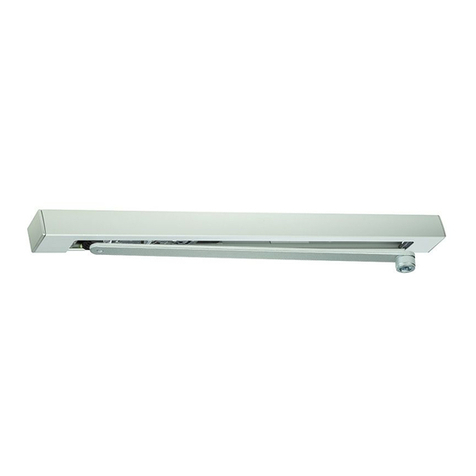
GEZE
GEZE TS 5000 E BG manual

raumplus
raumplus 800 AIR-B Series Assembly & installation

HOMEBUILDERS HARDWARE
HOMEBUILDERS HARDWARE LAWRENCE HARDWEAR 8016 Series Installation instruction

D+H
D+H BAZ 04-N-UT Original instructions

Langer & Laumann
Langer & Laumann QKS6 user manual
